An annual green that most foraging books ignore is making its winter debut locally, Parietaria floridana, or Pellitory. I saw the first sprouts a month ago. By now its a couple inches high, taller in a few select spots. Pellitory does not like a lot of direct sunlight so it is often found in shady areas, particularly beside fences. The plant will actually grow into lengthening shade as the sun grow lower in the winter sky. After the solstice and the sun starts to rise Pellitory will retreat into deeper shade until spring whereupon it will disappear until late fall. It’s actually a race between how fast the plant can grow in the diminishing shade. Pellitory in just the right spot can get up to about 14 inches high though a foot is more common. Also called “clearweed” because of its translucent stems, when crushed it smells lightly of cucumber, one of two plants locally that does. The other is a wild cucumber (Melothria pendula.) That little cuke is rather eye opener in that everyone tries it likes it and then finds sites that say it is toxic when their personal experience tells them it is not. Pellitory is a green and a medicine, specifically a diuretic. To read more about Pellitory click here.
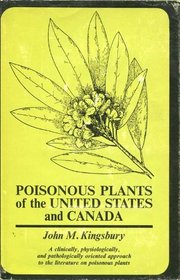 ♣Most of us have been told eating apple seeds is dangerous. That is usually followed by “there was a man who ate a cup of apple seeds and died…”
♣Most of us have been told eating apple seeds is dangerous. That is usually followed by “there was a man who ate a cup of apple seeds and died…”
Is that theoretically possible? Yes. You’d have to eat 85 grams of apples seeds, about three ounces, or about 114 seeds, all at one time, all thoroughly chewed. That could, in theory, deliver a fatal dose of cyanide. That’s for a 150 pound person, a larger person could tolerate more, a child much less. Probably children should not eat any apple seeds. The way cyanide works is rather fascinating. It attaches to our red blood cells better than oxygen. So instead of oxygen being delivered throughout the body for use cyanide is. We essentially suffocate. But what about the guy who ate the cup of seeds? There’s bit of a problem with that. You read about it here first.
In 1964 John Kingsbury, Phd., an expert on plant poisonings, particularly regarding farm animals, published Poisonous Plants of the United States and Canada, Prentice-Hall. He was the expert and his book became the book to reference. On page 365 Kingsbury wrote:
“Apple seeds are cyanogenetic. A man, who found apple seeds a delicacy, saved a cupful of them. Eating them at one time, he was killed by cyanide poisoning.”
Kingsbury’s inclusion of the incident in his book gave the story legitimacy and it has been quoted extensively ever since by professionals and amateurs alike. But from a journalistic point of view it is full of holes. Who ate the seeds, when, and where? Basic facts that add credibility. Professor that he was Kingsbury included where he got the story from in footnote 1335. That footnote reads: Reynard, G.B., and J.B.S. Norton in Poisonous Plants of Maryland in Relationship to Livestock. Maryland Agricultural Experimental Station, Technical Bulletin. A10, 1942. 312pp.
So Kingsbury in 1964 is quoting a farm bulletin from 1942. What does that bulletin say? On page 276 of the now 70-year old bulletin Reynard and Norton write about prussic acid harming livestock. (Amygdalin is essentially a sugar and cyanide molecule which when digested releases hydrogen cyanide which used to be called prussic acid.) They note in the last paragraph, below right:
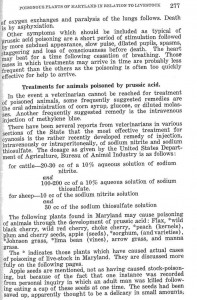 “Apple seeds are mentioned, not as having caused stock-poisoning, but because of the fact that one instance was recorded from personal inquiry in which an adult man was killed following eating a cup of these seeds at one time. The seeds had been saved up, apparently thought to be a delicacy in small amounts and upon being eaten developed enough of the deadly prussic acid to cause this tragic death. The instance is recorded here as a caution to others who might attempt to eat more than a few of these seeds at any one time. Previous investigators have reported that apple seeds contain appreciable amounts of amygdalin from which prussic acid is developed, but actual reports of poisoning are rare.”
“Apple seeds are mentioned, not as having caused stock-poisoning, but because of the fact that one instance was recorded from personal inquiry in which an adult man was killed following eating a cup of these seeds at one time. The seeds had been saved up, apparently thought to be a delicacy in small amounts and upon being eaten developed enough of the deadly prussic acid to cause this tragic death. The instance is recorded here as a caution to others who might attempt to eat more than a few of these seeds at any one time. Previous investigators have reported that apple seeds contain appreciable amounts of amygdalin from which prussic acid is developed, but actual reports of poisoning are rare.”
Livestock poisonings from prussic acid are “rare.” What of humans? A 130-year search of the New York Times by this writer produced 437 stories involving prussic acid. Those included suicides, murders and a few accidental medicinal deaths. None by an apple seed overdose. We are left with no who, no where, and no when as well as a “recorded from personal inquiry…” and “apparently.” Read someone told them it had happened. Their reference is as weak as Kingsbury’s. Without a name, a time and place it is not much better than an urban legend. It could have happened, or it just might be a story. More so, man has been eating apples for some 6,000 years. One would have thought in that amount of time it would have become common knowledge that you don’t eat a lot of apple seeds in one sitting. Also during the days of Johnny Appleseed everyone was making cider and there were millions of seeds available annually for decades if not centuries. One wouldn’t have to save them up at all. Getting rid of apple seeds was a problem, not getting enough of them. Also they dry out very quickly so if you saved only a few at at time by the time you had a cup that way the earlier seeds would not be edible. And with all those millions of seeds around and hungry people why only one report of an apple seed over dose?
We can’t say the story is not true, but we can call it doubtful. Click here to read about Wild Apples.
Botany Builder #7: Monocots and Dicots are usually easy to sort out and at a fundamental level help you from misidentifying a flowering plant. Monocots come out of the ground with one leaf. Dicots have two leaves. When older Monocots usually have parallel veins in their leaves, Dicot veins look like a road map. Monocot flowers parts are usually in multiples of three… such as three or six…think Daylily, to the left. Dicots have flower parts in multiples of four or five, like the natal plum below right. There are a few exceptions thus the distinction is not carved in botanical granite. Dicots are far more common than Monocots. There’s about 321 families of Dicots and 60 or so Monocots. Most trees are Dicots although palms and lilies are considered Monocot trees.
This presented me with a botanical headache one time. I found a tree I did not know. Its leaf looked like a Monocot yet the tree clearly was not a palm or a lily (you should know not everyone is happy with calling palms and lilies trees. The papaya is also a bit of an issue as well, tree or herb?) So I had a huge problem. It looked like a Monocot but that was not really possible. Said another way I couldn’t figure out which major division I needed to start with to identify the tree. So I did it the hard way. I took samples and went searching botanical gardens for a named example. I finally identified it as the Nagi Tree, in the podocarpus family, sometimes called the Broadleaf Podocarpus, a distant relative of the pine, which is a different Botany Builder altogether. Pines are gymnosperms, which means naked seeds… yes, gymnasium means a place where people exercise naked (because they used to exercise naked. Why get clothes dirty?)
♣ It was quite a week with classes Thursday through Sunday with large groups in Winter Park and Jacksonville. Met a lot of really nice people. A surprise in Winter Park was chickweed, perhaps a couple of weeks early though in cooler Jacksonville it was up and strong along with henbit (and it was cool there Sunday with a stiff breeze.) A surprising find in Jacksonville was a wild cucumber still producing. In fact it was full of fruit so everyone who wants some got to taste some. Upcoming classes this week are:
Saturday, December 17th, Mead Garden: 1500 S. Denning Dr., Winter Park, FL 32789. 9 a.m.
Sunday, December 18th, Bayshore Live Oak Park, 23157 Bayshore Rd., Port Charlotte, FL 33980, 9 a.m.
Several have signed up for the Port Charlotte class so that class will go as scheduled, and I get to ride south where it’s warm.
♣ On a personal note: In the news is the new Chevy Mailbu Eco hybrid which will be available soon. It will get 38 mpg on the highway and costs somewhere around $26,000 after a variety of deductions et cetera. I own two practical motorcycles. Some 93% of the miles I travel are on two wheels. The older bike — now 16 — is a Honda PC800, above left. It gets
55 mpg on the interstate at 70 mph. It has plenty of power, is like a sporty Cadillac to ride, and was designed for commuting and travel. I use it for all my out-of-town classes that require a trip of several hundred miles or more, which included a 272 mile round trip to Jacksonville in the rain with a 16 degree temperature differential (see, it can be done.) In town I ride a 12-year old Kawasaki 125 that gets 101 miles per gallon. Nimble and light it’s great for city use. Old, simple technology that doesn’t break down, great gas mileage, inexpensive to buy, own and run — total insurance for both motorcycles is $127 a year. Why is it that motorcycles (and mopeds) in the United States are not part of the push to be green and save energy and reduce the carbon footprint et cetera? They are in other countries. Maybe we’ve seen too many Hell’s Angels movies.
The long-paid for gray 1990 Volvo in the background gets 25 mpg highway and is driven once a month on average. It is by far more expensive to own and operate than the bikes. I do all the maintenance and repairs on all three vehicles. I’m not sure why I own a car. I got rid of my house phone long ago. Maybe it is time to retire the car as well.
♣ And for what it’s worth I am still looking for a webmaster. Perhaps you know of someone who will exchange webmastering for foraging lessons.
To donate to the Green Deane Newsletter click here.

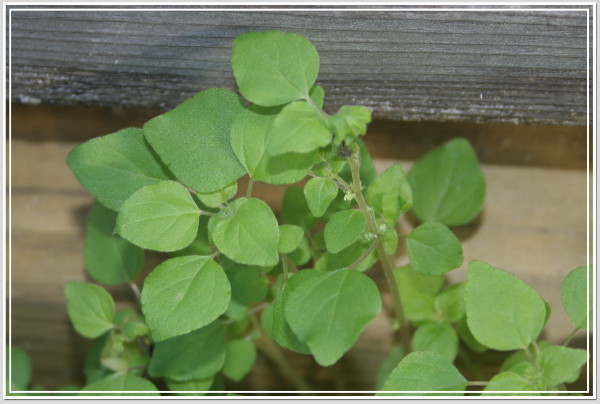
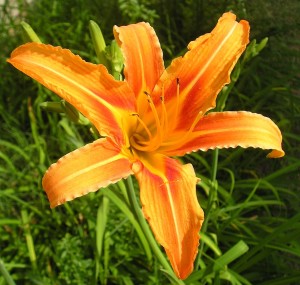
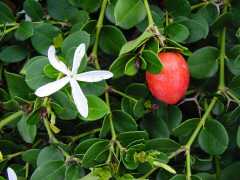
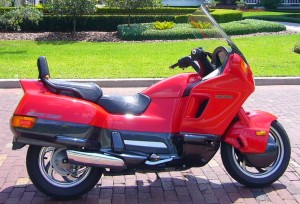
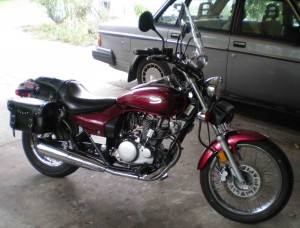

Hello Deane Green! Love the newsletter and website. I found it while trying to identify the delicious pindo palm fruits in my new back yard. Yes, I tasted before identifying because how can a close relative to the date be harmful?
We used 4 of the 5 pindo stalks that ripened this summer/fall. Uses to date: eating fresh, pureed for sorbet, freezer jam (no cooking), freezer jam with jalapeno, cut off the seed and dehydrated (nice punch to green salad), pureed and dehydrated as fruit leather. We love our Butia Capitata!
As a teen back in the ’70s, I bought Euell Gibbons’ ‘Stalking the wild asparagus’ and have enjoyed eating wild things ever since but am faced with a new learning curve having moved from WA to CA.
Sorry I can’t help you with a webmaster at this point. Will keep it in mind.
I agree with the idea of two-wheelers should be included in the green movement. I bought a new 1987 Kawasaki Voyager XII years back. Got 50 mpg, road it year round in Florida and most of the year in Arkansas. Yeah, even in 16 degree weather. Looking for another bike now for commuting back and forth to work in MS. Also more cities should look at providing bicycle lanes and paths. Seems that quick and simple fixes are ignored or overlooked here in the USA.
Loved the Dec 10th Mead Garden class. Really excellent. Best, Kim Northrop
Hi There! Thanks for coming to Jacksonville.
I look forward to your next visit here and will bring several others with me, including a 10-year old Boy Scout grandson who may never forgive me for having “snuck out to go on a foraging field trip without me!” as he said when he found out where I’d been.
Thanks again.
Regarding hydrogen cyanide in apple seeds, I’ve always wondered whether certain ways of processing apples wouldn’t deliver significant doses. For example, making apple sauce by cutting them (and some of their seeds), cooking, then running through a food mill. Or putting apples, seeds and all, through a juicer.
That is quite a question. There are a several possibilities. One is that cooking does not drive off the proto cyanide nor release it. This is why one does not have to remove the seeds of the pyracantha to make jelly. Cooked red elderberry seeds, however, are still toxic after cooking. However, at least two native grouns in the world learned you can take the kernel out of a plum seed, mash it, let it sit for a few days, bake it and eat it. In some the enzymatic process after being crushed gets rid of the proto cyanide. With some it take crushing, sitting and baking to rid it of the proto cyanide. And with others the proto cyanide stays regardless. Clearly we need a chemist.
The cyanide is no issue while locked to another molecule, usually a glycocyanide or a hycrocyanide. Digestion separates the two freeing the cyanide. One can thus see how enzymes do that seperation allowing for the release of the cyanide before consumption. Heat sometimes does it alone. The particular hydrocyanide in bamboo shoots is removed by cooking which is why one always cooks the shoots first.
Hey Deane,
I greatly appreciate your diligent search for the truth behind “the apple seed urban legend”. If you recall, we have discussed the Amygdalin dilemma in the past as it pertains to the balance between it’s established benefits and potential hazards. By established, I most assuredly do not reference the American allopathic medical industry. Nor do I dismiss the dangers inherent in such a compound. Your tenacity in seeking the truth builds credence to all the information you present.
I hope to be able to make it to more of your classes in the comming year.
If the work situation doesn’t pick up soon, I may have to subsist on what I have already learned.
This new format is much improved. (not that it wasn’t great before) Keep it coming. Hoyt
Very grateful to finally see a Natal Plum — something I’ve referred to as a Mexican Milk Apple. We’ve eaten them for years even though they have white ‘sap’ inside. Maybe now I can finally find out more about them. They are very plentiful here in San Diego County.
Thank you very much, Green Deane.
Mexican Milk Apple… hmmm.. Never heard of that. Yes they do grow in your area, usually used in landscaping. On a business trip one to San Diego I stayed at a hotel that had them in landscaping.